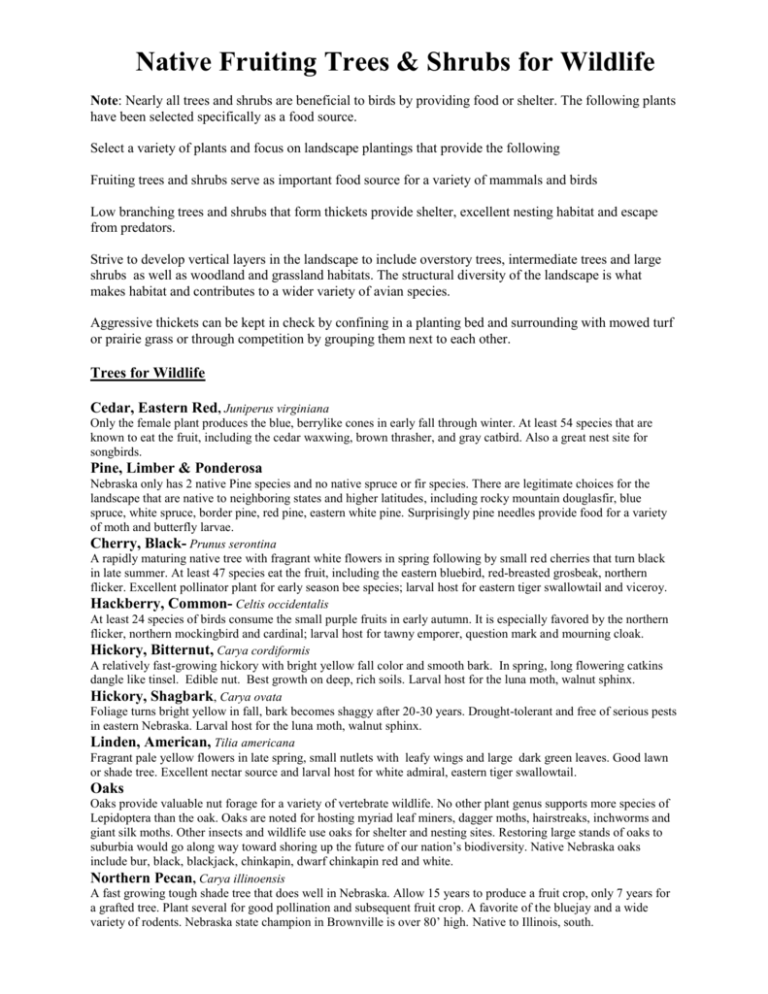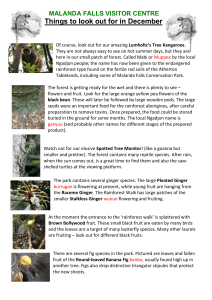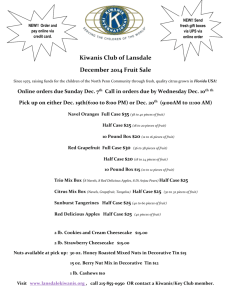Plants for Wildlife (songbirds, bees, butterflies)
advertisement

Native Fruiting Trees & Shrubs for Wildlife Note: Nearly all trees and shrubs are beneficial to birds by providing food or shelter. The following plants have been selected specifically as a food source. Select a variety of plants and focus on landscape plantings that provide the following Fruiting trees and shrubs serve as important food source for a variety of mammals and birds Low branching trees and shrubs that form thickets provide shelter, excellent nesting habitat and escape from predators. Strive to develop vertical layers in the landscape to include overstory trees, intermediate trees and large shrubs as well as woodland and grassland habitats. The structural diversity of the landscape is what makes habitat and contributes to a wider variety of avian species. Aggressive thickets can be kept in check by confining in a planting bed and surrounding with mowed turf or prairie grass or through competition by grouping them next to each other. Trees for Wildlife Cedar, Eastern Red, Juniperus virginiana Only the female plant produces the blue, berrylike cones in early fall through winter. At least 54 species that are known to eat the fruit, including the cedar waxwing, brown thrasher, and gray catbird. Also a great nest site for songbirds. Pine, Limber & Ponderosa Nebraska only has 2 native Pine species and no native spruce or fir species. There are legitimate choices for the landscape that are native to neighboring states and higher latitudes, including rocky mountain douglasfir, blue spruce, white spruce, border pine, red pine, eastern white pine. Surprisingly pine needles provide food for a variety of moth and butterfly larvae. Cherry, Black- Prunus serontina A rapidly maturing native tree with fragrant white flowers in spring following by small red cherries that turn black in late summer. At least 47 species eat the fruit, including the eastern bluebird, red-breasted grosbeak, northern flicker. Excellent pollinator plant for early season bee species; larval host for eastern tiger swallowtail and viceroy. Hackberry, Common- Celtis occidentalis At least 24 species of birds consume the small purple fruits in early autumn. It is especially favored by the northern flicker, northern mockingbird and cardinal; larval host for tawny emporer, question mark and mourning cloak. Hickory, Bitternut, Carya cordiformis A relatively fast-growing hickory with bright yellow fall color and smooth bark. In spring, long flowering catkins dangle like tinsel. Edible nut. Best growth on deep, rich soils. Larval host for the luna moth, walnut sphinx. Hickory, Shagbark, Carya ovata Foliage turns bright yellow in fall, bark becomes shaggy after 20-30 years. Drought-tolerant and free of serious pests in eastern Nebraska. Larval host for the luna moth, walnut sphinx. Linden, American, Tilia americana Fragrant pale yellow flowers in late spring, small nutlets with leafy wings and large dark green leaves. Good lawn or shade tree. Excellent nectar source and larval host for white admiral, eastern tiger swallowtail. Oaks Oaks provide valuable nut forage for a variety of vertebrate wildlife. No other plant genus supports more species of Lepidoptera than the oak. Oaks are noted for hosting myriad leaf miners, dagger moths, hairstreaks, inchworms and giant silk moths. Other insects and wildlife use oaks for shelter and nesting sites. Restoring large stands of oaks to suburbia would go along way toward shoring up the future of our nation’s biodiversity. Native Nebraska oaks include bur, black, blackjack, chinkapin, dwarf chinkapin red and white. Northern Pecan, Carya illinoensis A fast growing tough shade tree that does well in Nebraska. Allow 15 years to produce a fruit crop, only 7 years for a grafted tree. Plant several for good pollination and subsequent fruit crop. A favorite of the bluejay and a wide variety of rodents. Nebraska state champion in Brownville is over 80’ high. Native to Illinois, south. Walnut, Black, Juglans nigra Dark green leaves with yellow fall color. Edible, oily nuts are an important food source for small mammals. Prefers moist, well-drained soil, rich and deep soil full sun. Larval host for a variety of butterflies and moths. Intermediate Trees for Part Shade --15-35’ Birch, River, Betula nigra Bark exfoliates in papery strips to reveal orange-brown inner bark; Prefers organic, well-drained soils. Preferably afternoon, shade. Native to southeastern Iowa. Birch, Paper, Betula papyrifera Black marks on white bark when mature. Wet, well-drained sandy or rocky loams in part, preferably afternoon, shade. Native to Niobrare valley. Native to the Niobrara valley. Buckeye, Ohio, Aesculus glabra var. arguta Very adaptable Midwest native. Interesting chartreuse flower panicles in spring followed by prickly seed pods in late summer. Starry foliage turns orange-red in fall. Prefers part shade. Native to Richardson CO. Dogwood, Pagoda, Cornus alternifolia Distinctive horizontal branching. Fragrant, yellow/white flowers in flattened cymes late spring followed by black fruits relished by songbirds. Prefers organic, well-drained soils. 15-20.’ Native to IA, MN, MO. Hophornbeam, American, Ostrya virginiana Catkin flowers in spring become hoplike fruits in late summer. Dark green leaves turn buttery yellow in fall. Grows in full sun to part shade in well-drained soil. Native to Missouri river valley up into Niobrara valley. Juneberry, Downy, Amelanchier arborea Beautiful snow white flowers bloom in spring and give way to edible, dark purple, blueberry-like fruits. Bluishgreen leaves turn orange-red in fall. Full to part sun, tolerates a range of soil conditions. Native to SE NE. Pawpaw- Asimina triloba Larval host for the Zebra swallowtail butterfly; The largest native fruit, with up to one pound with a rich, custardstrawberry, banana flavor. Best growth in rich, moist high organic soil, although tolerant of clay. Will also tolerate a lot of shade. Two trees are required for fruit set and fruiting usually occurs after 4-8 years. Pawpaw has twenty times as much iron, ten times as much calcium, and up to twenty times as much magnesium as do banana, apple or orange. They contain compounds which have been shown to inhibit mammalian solid tumor cells a billion times lower than the most common anti-tumor drug. Bark extract of pawpaw has shown excellent pesticidal and antifungal activity. 20’ high, 15’ wide; larval food source for the zebra swallowtail. Native to SE NE. Persimmon- Diospyros virginiana The persimmon is one of the most luscious and sweet fruits when it has truly ripened, usually after a frost or two. The bobwhite, eastern bluebird and many other species eat the fruit that can persist well into winter. Plant more than two trees for fruit set. 45’ high, 35’ wide; larval host of the luna moth. Native to NW Missouri. Intermediate Trees for Full Sun Blackgum, Nyssa sylvatica The waxy leaves turn lustrous red in fall; beautiful horizontal branching patterns; silvery bark on young stems and dark alligator bark. Prefers deep, well-drained soil, resists drought and short term flooding. Heavy nectar producer for native bees and honey bees; excellent fruit for a number of birds. Native to KS, MO, IL Crabapple, Prairie, Malus ioensis This is the crabapple of the eastern prairie region in the upper Mississippi Valley. A handsome double-flowered variety is grown as an ornamental. Numerous species of birds, including bobwhites and pheasants, and squirrels, rabbits, and other mammals consume the fruit. Oak, Dwarf Chinkapin- Quercus prinoides This small oak, native to southeastern Nebraska, produces a bountiful crop of acorns every three years. It provides the preferred food of turkey, bobwhite quail, bluejay and rufous-sided towhee. Grows 15-20’ h. Native to SE NE. Large Shrubs for Full Sun Buffaloberry- Shepherdia argentea This is a much-branched native shrub that is armed with sharp twigs. The ¼” fruit becomes glossy and red-orange when ripe. Dried fruit can be used like raisins or made into jelly or pie. Two trees are required for fruit set. The selection ‘Sakakawea’ was noted for its excellent growth in trials. Prefers dry soils. 15’ high, 10-15’ wide. At least 12 birds enjoy its fruit, including the robin and sharp-tailed grouse. Red Gooseberry- Ribes x ‘Red Jacket’- The ½” fruits are deep reddish purple and quite tart. Comanche Gooseberry- Ribes uva-crispa ‘Comanche’- High yields of “sweet” juicy fruit. Black Currant- Ribes americanum- Pleasant tasting currant, high in iron and other minerals. Crandall Clove Currant- Ribes odoratum ‘Crandall’- Selected for excellent, large fruit quality. Red Lake Currant- Ribes sativum ‘Red Lake’- Beautiful red berries in long, easy to pick clusters Plum, Wild- Prunus Americana Profuse flowering and fruiting make this native shrub a favorite in edible landscapes. There is quite a bit of variation in fruit size and color, varying from yellow to red. There are selections available that offer a more tree-type growth and others that produce a higher fruit quality. The plum juice is high in pectin and when mixed with other fruits it causes them to jell. The fruit can be processed into jelly, jam, a spiced plum sauce or dried for a trail mix. 12-15’ high, 12-15’ wide; early season host for many pollinators; larval host for tiger swallowtail; Plum, Chickasaw- Prunus angustifolia Profuse flowering and fruiting make this southern Great Plains shrub a nice alternative to wild plum. This species offers a more tree-type growth and doesn’t sucker. Can grow to 15’ or more. Native to KS, OK, MO. Rose Hips- Rosa species Rose fruits, called hips, are valued for their high content of vitamin C and for their flavor. Hardy shrub roses and wild roses provide excellent nesting cover and food to at least 20 species of songbirds. Sandcherry, Western- Prunus besseyi A suckering, spreading 4-6’ high shrub native to northern and western Nebraska. It prefers a well-drained soil for longevity and will thrive in a sandy soil. It will not tolerate heavy clay and wet conditions. Cultivars have been selected for fruit quality with ‘Black Beauty’ (small, black and sweet) and ‘Hansen’s’ (large, purple-black, flavorful). The large, bing-cherry sized fruit will bear heavy around every third year. It is eaten by the ring-necked pheasant and other birds. Snowberry- Symphoricarpos albus This thicket forming shrub is easy to grow in a variety of soils. Its berries ripen in early fall and persist into late fall. It is an important source of late season food for ring-neck pheasant, robin and cedar waxwing to name a few. Grows to 4-6’ high and can be pruned back hard each spring. Sumac, Staghorn- Rhus species This native shrub has a dense form when young and then opens up with age. At least 31 species are known to eat the colorful red fruits that persist into winter. They provide a great “emergency” food for winter; larval host for redbanded hairstreak. Shrubs for Wet Soils Buttonbush, Cephalanthus occidentalis A favorite of bees; honey scented; important summer nectar source; waterfowl feast on seed heads in late fall. A native of lowland, swampy areas this large shrub can grow in a variety of soils and is also drought tolerant. Grows 12-15’ high. Larval host for sphinx moths, tawny-edged skipper, among others. Dogwood, Silky, Cornus ammomum This dogwood thrives in moist areas and produces pale blue clusters of bitter but aromatic berries; high in food value to at least 18 species. Tolerates wet soils. 10’ h, 8’ w. Dogwoods are host plants for spring azure butterflies. Elderberry- Sambucus canadensis Well known native fruit plant used to make everything from pancake syrup to wine. Fast growing to 6-10’ and easy to grow in any soil. Probably the highest iron content of any native fruit. Needs to be pruned every couple of years to force new canes otherwise the fruit production drops off. The variety ‘Adams’ was selected for its heavy fruiting. It is known to attract at least 33 different species including the red-headed woodpecker, eastern bluebird and cardinal; the old stems provide over-wintering sites for insects; fragrant white flowers attract many pollinators. False Indigo, Amorpha fruticosa Bushy, suckering plant can grow to 12’ or more. Cut to ground every few years to rejuvenate; compound foliage looks like a small honeylocust tree; dark purple flowers. Viburnum, Arrowwood, Viburnum dentatum White flowers in spring give way to dark blue fruits in summer relished by song birds. Full to part sun in average, well-drained soil. Many outstanding cultivars. Plant more than one variety for cross pollination and more fruiting. Can grow from 6’ to 12’ depending on the cultivar; larval host for the spring azure. Viburnum, Nannyberry, Viburnum lentago Shrubs for Part Shade Chokecherry- Prunus virginiana A large native shrub often occurring in thickets. They are easily contained using a mower to keep the suckers confined to a certain area. The juicy fruit turns a deep red purple to black when ripe and are borne in long clusters. Once known as rumcherries because they were often added to rum and brandy. Surprisingly, they tolerate a lot of shade. Exceptional syrup, jelly and wine! Bladdernut, Staphylea trifoliata A native understory shrub that suckers to form thickets. Early spring flowers are somewhat showy and unusual, emerging before the foliage; attractive foliage turns yellow in fall; inflated seed pods develop in summer and persist all winter; attractive bark with whitish striping; grows to around 8’ high and wide. Coralberry- Symphoricarpos orbiculatus This deciduous, bushy dense shrub has small pinkish flowers in late summer, followed by round, deep rose-purple berries that persist through winter. At least 14 species eat the fruit, including the American robin. 3-5’ h, 4-6’ w. Dogwood, Rough-Leaf, Cornus drummondii Flowers enjoyed by bees; white clusters of berries in fall a favorite of songbirds. Reddish purple fall color. Easy to grow, but will sucker aggressively. Plant in confined space. Excellent thicket for shelter and nesting. 15’ h, 12’ w. Hazelnut, American, Corylus americana This easy to grow suckering shrub grows naturally along the woodland edge, seldom growing outside the canopy of larger trees. They tolerate full sun, but do best in part shade and shelter from strong winds. Some years are copious fruit crops relished by a variety of critters. Can grow up to 10’ high and wide. Juneberry- Amelanchier species The native juneberry or serviceberry can be a bush type or tree type with profuse fruiting. Ripening in June, the fruits are delicious. This is an important summer food for many songbirds. Easy to pick and prepare and this plant performs in sun or part shade. Look for selections of the Saskatoon Serviceberry (Amelanchier alnifolia) the 4’ high ‘Regent’ selected for large fruits. Serviceberries have 10 times more vitamin C than blueberries. The downy serviceberry, A. arborea, a native understory along the Missouri bluffs, attracts at least 19 different birds. All are excellent pollinator species, attracting many bee species in early spring; larval host for tiger swallowtail. Spicebush, Lindera benzoin An attractive shrub for part shade or full sun; early season flowers emerge before the foliage and attract a variety of bees; handsome foliage turns yellow in fall; beautiful cardinal red fruit in fall; larval host for the rare spicebush swallowtail butterfly. Grows up to 8’ h, 6’ wide. Native to MO, IA, IL. Viburnum- blackhaw, American cranberrybush, linden, The blue to black or red fruits of viburnums are some of the best for attracting songbirds. They also provide excellent cover for nesting. Plant in groups for better fruit set. Native to KS, MO, IA, MN








